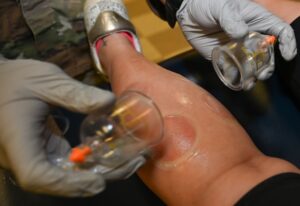
Story by Airman 1st Class Nelvis Sera
Air University Public Affairs
MAXWELL AIR FORCE BASE, Ala.— U.S. Air Force Senior Airman Christopher Neal, 42nd Medical Group physical medicine technician, supports the Human Performance Flight by delivering targeted physical therapy services to Airmen.
“With fewer than 300 physical medicine technicians across the Air Force, the Human Performance Flight consists of two elements, physical therapy and optometry,” said U.S. Air Force Tech. Sgt. Gabino Gutierrez, 42nd Medical Group physical therapy and optometry flight chief. “The flight ensures Airmen maintain peak physical and visual health, enhancing their performance and overall mission success.”
Neal was drawn to serve in the military through his father, a former police officer and military veteran. After sustaining multiple sports-related injuries throughout his youth, he developed an interest in physical rehabilitation and earned a bachelor’s degree in health promotion from Morehead State University in 2020.
“As a student athletic trainer at Morehead, I worked with football, soccer, basketball and beach volleyball teams,” said Neal. “I gained hands-on experience in injury prevention and recovery.”
Neal is part of a two-person PT team that supports a wide range of patients. The clinic averages 80 to 120 patients per week, with many receiving multiple sessions, especially post-operative patients.
“Our primary group of patients are students, mostly majors and lieutenant colonels, who finally have time to take care of themselves,” said Neal. “They’re often in that 11-to-18-year mark in their careers, and by then, their bodies have taken a beating. We try to get them as close to 100% as we can while they’re here.”
Each treatment plan is customized, using a variety of techniques tailored to individual needs.
“Each patient is like a puzzle,” said Neal. “What works for one person might not work for the next. That’s part of what makes this job so rewarding, you build relationships while trying to figure out what’s best for them.”
Gregory Norris, 42nd Medical Group physical medicine technician, uses various treatments including dry needling, cupping and cryotherapy with the Game Ready machine.
“Dry needling targets muscle knots,” said Norris. “It is an 80% effective treatment for musculoskeletal pain and ligament strains.”
Neal explained that while athletic training focuses on improving performance in healthy individuals, PT is oriented toward recovery and rehabilitation.
“Some treatments involve discomfort, particularly when addressing muscle restrictions or joint limitations,” Neal said. “However, our objective is always improvement, whether that’s preparing someone for a physical fitness assessment or supporting deployment readiness.”
He uses Cross-Fit style functional workouts to build cardiovascular strength. PT has evolved to incorporate high-intensity interval training for patients who like being challenged.
“We try to meet people where they are,” said Neal. “We get everything from former Division I athletes to Airmen who never ran until basic training. So, it’s important to set expectations, ask what people want out of treatment and adjust our plans to help them reach their goals.”
Looking ahead, Neal plans to start a new career in law enforcement, where he can continue helping others.